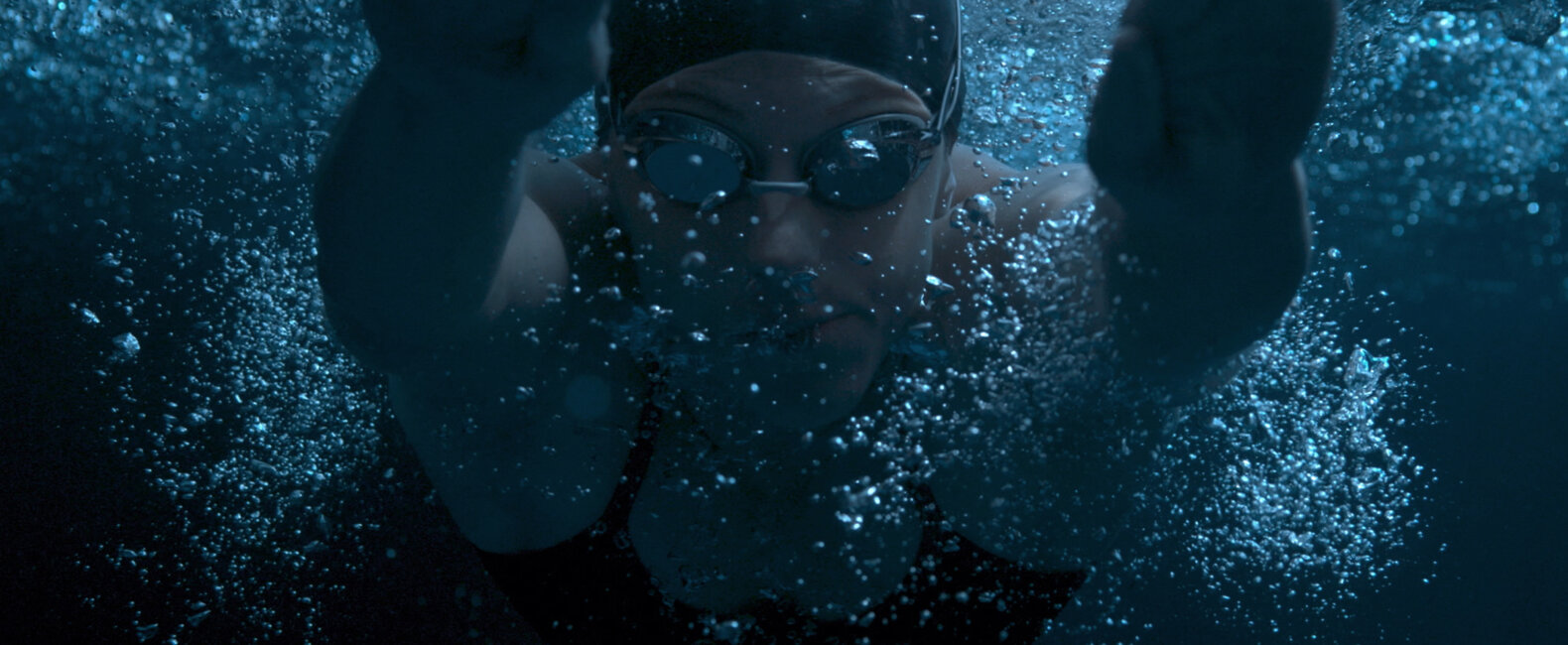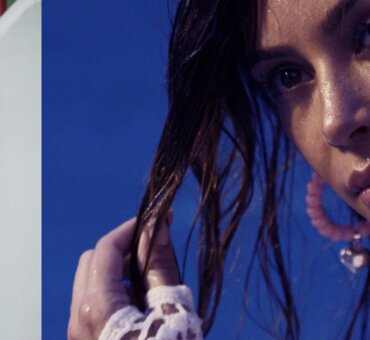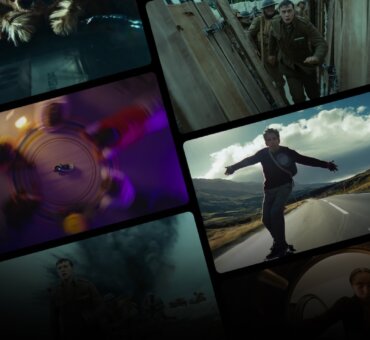To Those Who Doubt is a short film shot in ultra slow-motion and set almost entirely underwater. A passion project by the talented team at Evolve, it contains some of the most striking underwater footage we’ve ever seen. The film was so technically challenging, the script (a charge to overcome uncertainty and jump off high platforms) was born from the team’s fears about the project not coming together. “Jesse was so nervous, he wrote the script about it,” Joel Edwards tells us, laughing. Joel, we should tell you, is Jesse’s brother.
But like most people who stay up all night creating passion projects in high-risk environments, the Edwards brothers found more inspiration than discouragement in the challenge. They threw themselves into the project, literally, and the result is a breathtaking artistic and technical achievement.
We talked with Joel and Jesse Edwards about how they pulled it off.
Filmsupply: What are some of the challenges on an underwater shoot like this?
Joel Edwards: Well, shooting underwater is the challenge. We had this amazing inspiration photograph we were working from, but we wanted to do ours with motion. And in order to feel all of the minute elements and macro details under the water, you want to go as slowly as possible—120 frames per second isn’t going to cut it. You’re talking 500 to 1,000 frames if you really want to feel it. And technically, that’s a huge challenge. We shot this on a Phantom Flex4K—a $200,000 camera. And we shot the whole thing on Summicron glass, which is great glass.
But even with all of that great gear, it’s tough to get the shots you’re after. It’s very tough to focus when you shoot all the way open like we were. You have to shoot in a location where you have complete control, where you can turn off all the lights to avoid flicker. The refresh rates in those cameras are tough to deal with, so you have to do your own flicker-free ballast lighting. And we had to find a huge swimming pool so we could fit the swimmers inside the frame. We didn’t have money to light the whole pool, so we were lighting just one corner of it. There was this lighting sweet spot, and if we didn’t get the focus and subject action within that exact spot, it was a bad take.
How did you manage to get the camera movement under water?
Joel Edwards: We created a pulley system. It took three guys to pull Jesse through the water. They were chugging Jesse around, and I was up top yelling at the lighting guys to swing a light on a menace arm to make sure we were getting the right illumination. It was super challenging.
Jesse Edwards: We had to make sure the talent was looking awesome in the exact right place at the exact right time. Because it was so slow-motion, we wanted the camera to be constantly moving through bubbles or particles or whatever. I think we were shooting at 800 frames a second.
Joel Edwards: Between 600 and 800 frames the whole time.
Jesse Edwards: And we were all the way open.
Joel Edwards: T2. We literally had about 20 feet of sweet spot light. We had two 20-foot menace arms holding fixtures above the water. You can’t have crazy heavy fixtures on those arms. They have to be very lightweight. So that limits the amount of source you can pump into it.
Jesse Edwards: It was a little scary because there was definitely some water splashing up on those.
Joel Edwards: It was dicey. Our best boy was freaking out. He goes, ‘Guys, guys, guys. A hundred thousand gallons of water and HMI cables everywhere? This is going to be a bad night.’ And we were like, ‘Nah, dude! It’s all good!’ But we knew it was a very, very difficult challenge. And I think we thrived on that.
How did you keep everything in focus?
Joel Edwards: The whole thing was hand cranked, hand pulled. The camera was moving, so a set focus wouldn’t work unless we could somehow keep the camera and the talent at the same distance from each other. But there was no way to do that. And there really wasn’t much room for error. At full speed these shots lasted only a couple of seconds, and Jesse did an amazing job. Several shots were so amazing that we don’t know how they happened. I think The Force was strong with him that night.
Jesse Edwards: Joel was just like, “Stay on target.”
Joel Edwards: At 800 frames, there’s no forgiveness. You’ll see every single detail for like 30 seconds.
Can you describe this pulley system you rigged up?
Jesse Edwards: We used that rope you’d use for water-skiing, and we hooked it up to my harness. I was wearing a buoyancy control device, so I had about 30 pounds of weight on, plus the camera, which was about 80 pounds. Plus me, I’m 190. So altogether I was over 300 pounds and couldn’t swim fast enough to keep up with these swimmers. So we hooked this rope to my buoyancy control device, and they’d pull the rope as hard as they could.
At first we tried setting up these pulleys, but they didn’t end up working because the anchor point forced me to end up in one spot. We couldn’t adjust a bit to the left or right like we needed to. So basically they just attached the rope to me and then pulled. The tricky thing was that as they pulled me, I’d start to surface. So we figured out that I had to kick against the rope at the same time they were pulling me, and then I’d stay six feet down. I just kicked as fast as I could. So I’m kicking down, and they’re pulling me back, and I’m controlling the camera at the same time. There are some really expensive rigs you can get that will do the same thing, but ours was cheap and simple and worked really well.
How did you communicate?
Jesse Edwards: We’d planned to have a hydrophone, which is an underwater loudspeaker system. But the one we paid for didn’t show up. I think FedEx lost it or something.
Joel Edwards: So Jesse was underwater the whole time, and I was yelling at him.
Jesse Edwards: Unfortunately, you can’t actually hear someone talking while you’re underwater. But you can hear clicks. If you hit your ring against the side of the pool, you get these clicking noises. So Joel would signal to our dive master, who was on the surface, and she’d count down the shot with clicks. I’d start to swim and get pulled back, and then the diver would dive. Basically, it was an old-fashioned “Three, two, one… go!”
That sounds super tough. How often did you have to dump footage?
Joel Edwards: We had a two terabyte mag, but we knew we had to be very selective about what we were saving and what we were throwing away. That stuff can add up very quickly if you’re carelessly saving every shot.
Are all the particles real?
Joel Edwards: Yep. Nothing added. Most of the visual effects we did were removals. There were some shots that had light stands in them, and some shots needed to be cleaned up a little. We did a ton of selective sharpening. When you’re wide open like that, it gets really messy. So we were blurring and masking and sharpening a lot to make everything as pristine as possible.
How many takes did you guys do?
Jesse Edwards: I want to say 50 shots. Somewhere around 50.
Were there any unexpected challenges?
Jesse Edwards: There was one thing. To get the camera on a 50 mm lens underwater, you have to use a diopter so the focus goes where it’s supposed to. Otherwise, the domed port on the housing skews your focus, and you can’t get close enough. I think your focus starts at six or eight feet instead of 18 inches, so you use a diopter. But when you go above the water, the need for it goes away. So we weren’t able to get a shot where we started above the water and fell down underneath. We just didn’t have that kind of flexibility.
Joel Edwards: It was also very difficult from a lighting standpoint to light well for above and below the water with limited resources.
Joel Edwards: Once the light hits the water, it spreads completely differently than it does above the water. Some of it is bouncing off the pool. Some is coming underneath. It’s just this massive spill source underneath the surface; but above the surface, it’s incredibly punchy and harsh. We were essentially using PAR HMIs. We did one through gel to get the cold blue and green tones, but everything else was daylight.
We were trying to get good skin tones but also set a really cold blue environment. We were mixing sources and mixing temperatures. Above the water it looked absolutely terrible. But underwater it looked amazing.
What should a person know before doing an underwater shoot?
Joel Edwards: Get a support diver.
Jesse Edwards: That’s exactly what I was going to say. It’s one thing to scuba-dive. It’s another thing to scuba-dive with a 120 pounds of gear while attempting to operate a camera. And second, find a good underwater tech and pay them. Don’t just call in a favor. Because if they don’t show up, you’re screwed.
Another good note to make is that when we work underwater, we usually run a post-trigger, which gives you a certain amount of seconds saved after you trigger. The strategy there is that once you see what you want and it’s good and you know you’ve got it, you trigger. That is very challenging to do underwater where everything is slower. It’s physically challenging just to press the buttons. Everything is weird. You’re on high alert for the whole shoot until you’re out and it’s done and you’re looking at your shots on a computer. And then you’re finally like, Okay, we did it. There it is. Before then, it’s like you’re in a dream world.
Evolve is an Emmy-winning production company founded by filmmakers Joel and Jesse Edwards. To license footage from To Those Who Doubt, and to see more footage, head over to their contributor page.






